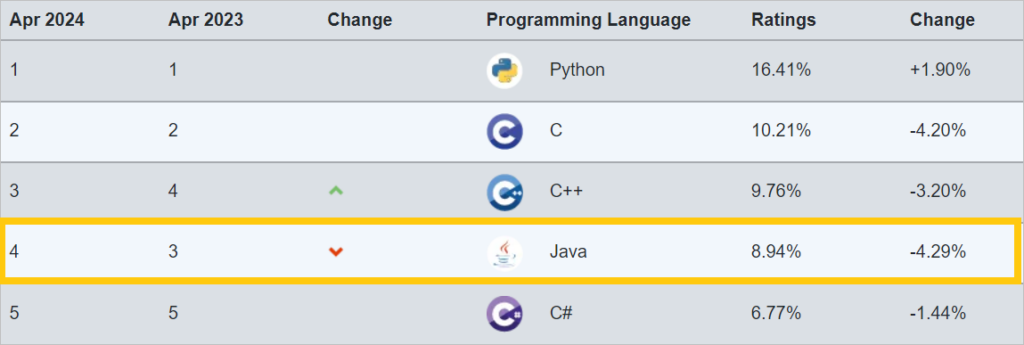While you might have heard of multiple programming languages today, Java ranks among the top 5 programming languages according to the TIOBE Index. For more than 20 years, Java has been in the industry and is still used by nearly 30.55% of developers.

No matter whether you are a beginner in the IT industry or want to learn Java as an additional skill, anyone can join us. We have created more than 30,000 tech experts in the industry, and we believe providing a practical approach to Java training can help students launch better jobs.
Therefore, we have researched and created a list of Java projects for CSE final-year students and other Java professionals.
These projects will clarify your Java concepts and highlight your skills when added to resumes.
Here are the best Java final-year projects at a glance:
- Life Line – A Health Assistance Web App
- Online Medicine Shopping System
- Online Auction Application (e-Auction)
- Online Banking Application
- Airline Reservation System
- Course Management System
- Electric Billing System
- Tourist Guide Android App
- Attendance Management System
- Internet Service Provider Automation System
- E-mail Client Software
- Exam Seating Arrangement System
- Consumer Relationship Management Tool
- Supply Chain Management System
- Criminal Face Detection System
👉 At codegnan, we offer practical Java training classes with practical projects and live tests that will help you become a better Java developer. Also, we provide complete job and internship assistance after our Java course completion.
Enroll in Core Java classes (and get 100% placement support):
Best Java projects for CSE final-year students
1. Life Line- A Health Assistance Web Application
Life Line is a health assistance web application built with Java programming that helps users track health data. It includes fetching health records, ordering medicines, comparing bed costs, booking beds, finding doctors, checking test reports, and multiple other functions.
Learning outcomes:
- Gain experience with core Java web development frameworks like JSF or Spring
- Knowledge of database management to store user information and health details
- Understanding of user interface designing that helps you create a user-friendly and interactive interface
- Implementation of security measures to protect sensitive health data
What it takes to execute this project:
- Download and install the JDK (Java Development Kit) and a code editor like Eclipse
- Select a web framework like Spring or JSF for building the web application structure
- Plan the structure of the database to store user details, health data, and other potential health resources
- Build the required functionalities like user registration, login, data entry forms, and integrating educational content retrieval
- Thoroughly test the application to ensure all functions are correctly working and deploy it to a web server so that users can access it via a browser
Real-world applications:
- Store and track personal medical history and medications
- Assist users with chronic conditions to monitor their health vitals and track the treatment progress
- Integrate with multiple health information databases to offer users reliable information on different health topics
- Book hospital beds and get doctors’ appointments faster so that there’s no delay in the treatment process
- Order medicines online and get them delivered to your home, reducing your hassles
2. Online Medicine Shopping System
This online medicine shopping system project aims to build an e-commerce platform where users can order medicines online. It will include functionalities like tracking whether a medicine is available, its components, and side effects, adding medicines to a cart and ordering it, and paying for it online.
Learning outcomes:
- Better understanding of Java elements and their implementations in building a web application
- Work with Java web development frameworks like Spring MVC or JSF (Java Server Faces) for building online store functionalities
- Connect the application to a database for storing medicine and other information, user details, orders, and managing inventory levels
- Implement multiple E-Commerce features like payment gateway, shopping carts, and order tracking functionality
- Use of advanced security features to protect user information
- You can also learn about web frameworks like Spring or JavaServer Pages for developing a user-friendly web interface
What it takes to execute this project:
- Set up your Java development environment and Eclipse IDE
- Select a web framework like Spring MVC or JSF for building the application structure
- Design your database to store information about medicines, users, and orders
- Build a few features of the project like a user registration and login system, a product catalogue, shopping cart functionality, an order processing system, and payment gateway integration
Real-world applications:
- Upload prescriptions and order required medicines
- Check out the details of the medicines, especially their components and side effects
- Look into the product catalogue to find out if some medicines are available or not
- Video consultation with doctors during emergency
- Delivery tracking of medicine orders and other health equipment
3. Online Auction Application (e-Auction)
This online auction web application project aims to create a platform for users to sell something in an auction or bid on products they want to buy. Users can register themselves as buyers or sellers, list items with descriptions and prices, browse items, place bids, and track their auctions.
Learning outcomes:
- You will have a clear understanding of core Java concepts like object-oriented programming, data structure, and control flow statements
- Knowledge of Java Database Connectivity (JDBC) to connect your web application to a database to store user data, auction items, bid results, etc.
- Work with Java frameworks like Spring or Spark for handling user requests, processing bids, and managing auctions
- Learn web development concepts and handling of user inputs
What it takes to execute this project:
- Set up web application development environment, install JDK and code editor like Eclipse
- Choose a database like MySQL or SQLite to store information about users and auctions
- Use a Java Framework like Spring or Spark for a smooth web development process
- Design the user interface for your auction platform
- Develop core functionalities like user registration, login, item listing, and basic bidding
- Test your web application thoroughly and fix errors before deploying them into the market
Real-world applications:
- Sell used goods at the best prices
- Buy used products of assured quality at a cheaper price
- Selling and buying of antique or vintage items
- Charities can raise funds by auctioning on such platforms
4. Online Banking Application
This project will create an online banking platform where users can transfer money, check account balances, and do other banking operations. It is a simplified replica of an online banking system where we won’t connect the application with real bank accounts for security purposes.
Learning outcomes:
- Get hands-on training on core Java concepts like classes, objects, datatypes, loops, conditional statements, etc
- Use of Java Collections like ArrayList for storing information related to user accounts and transaction history
- Learn file-handling techniques
- Knowledge of security measures to build a reliable system
What it takes to execute this project:
- Set up your Java development environment with JDK and Eclipse
- Design a simple user interface to navigate through the functionalities like viewing account balance, transaction history, etc
- Develop core functionalities like user log in, account balance display, and money transaction options
- Use user-defined passwords for login and validate user input to prevent unexpected data entry
- Test your application and fix any errors before deploying it in the market
Real-world applications:
- Send and receive money online
- Automatic bill payment scheduling
- Manage finances using a mobile banking application
- Apply for banking products
5. Airline reservation system
This Airline reservation system allows users to make reservations and cancellations, hold passenger records, and maintain routing operations and advanced functionalities (optional). It saves passengers from travelling to the airport to reserve tickets or find out seat availability.
Learning outcomes:
- Clear understanding of Java fundamentals like datatypes, variables, operators, and control flow statements
- Knowledge of how to work with arrays for storing and managing flight information like flight number, starting and destination timings, available seats, etc
- Understanding how to handle user inputs
- Building a user-friendly interface for the application
What it takes to execute this project:
- Set up your Java development environment by downloading and installing a Java IDE like Eclipse
- Design a user-friendly interface for your application and build its core functionalities
- Testing the application thoroughly to identify errors and resolve them
Real-world applications:
- Allows users to reserve airline tickets on time and avoid the hassle of visiting airports
- Check for seat availability in real time
- Easy cancellation of tickets at times of emergency
6. Course management system
A course management system project aims to build a web platform that allows users to organise course information and student data. It is a digital tool that will help students and teachers find details on a course, manage assignments, track grades, and view notices. You can add multiple other functions to the system.
Learning outcomes:
- Get a clear concept of Java Object Oriented programming, like creating classes for courses, students, and assignments
- Learn about data structures used to store course data, user details, assignments, and grades
- Knowledge of file-handling techniques to store and load course data from files
- Building a user-friendly interface
What it takes to execute this project:
- Set up the development environment, download and install a Java IDE like Eclipse
- Decide on the application functionalities that you want to include, like course management, student details view, assignments, etc., and design Java classes to represent each of these entities
- Develop the core functionalities for the project, such as registration, login, creating courses, etc.
- Build a basic user interface for an interactive user experience
- Test your codes thoroughly, identify and resolve errors, and deploy the system in real-time
Real-world applications:
- Used in institutions to list their courses and allow students to view details and choose courses of their choice
- Used in business sectors to list employee training courses for employees and trainees from different departments
- Used by the government to list free courses for citizens and help people grow in different sectors
7. Electric billing system
This project replicates an original electricity billing system where a person collects data from your electricity meter. The main objective of this project is to automate the entire process, compute the electric bill amount on the basis of units of electricity consumed, apply different tariff rates based on usage, and generate bills with details like consumed units, charges, and bill due date.
Learning outcomes:
- You will learn how to create classes and have a basic understanding of object-oriented programming
- Design a user-friendly interface for managing data and generating bills
- Knowledge of file handling techniques to store consumer data and bill information using files are databases
- Use of conditioner statements and loops in Java to calculate bills based on usage and apply different tariff rates
What it takes to execute this project:
- Download and install JDK and Eclipse IDE to set up your development environment
- Decide on the functionalities and design classes for your project
- Focus on core functionalities like adding customers, recording meter readings, calculating units consumed, and generating bills
- Build a user-friendly interface to make the application accessible on different devices and add extra features (if needed)
- Test your program thoroughly to ensure the application is free from bugs and ready to deploy in the market
Real-world applications:
- Small electricity providers can use it to manage their customer data, generate bills, and track customer payments
- Society management systems can use such a tool to calculate electricity bills for individual apartments within a society
- Hotels and guest houses can use it to calculate the daily electricity consumption of guests
8. Tourist Guide Android App
This tourist guide Android app aims to assist travellers in finding their ideal locations, highlighting interesting places of tourist attraction, and providing the necessary information. You will develop multiple features within this project, including listing popular tourist destinations with their descriptions and photos, integrating maps to show locations, and adding optional features.
Learning outcomes:
- Learn the core concepts of Java programming language for Android
- Knowledge of XML for the design or layout of the app
- Use of a database for storing information
- Implementation of location-based services to integrate map functionalities
What it takes to execute this project:
- Download and install Android Studio for building Android applications
- Decide and the core functionalities and design your app layout
- Add the core functionalities of the application
- Use arrays or lists to store data
- Implement map integration and work on user interface improvements
- Run the application on an Android emulator to identify and fix errors
Real-world applications:
- Local tourist guides, can you use the app to help clients visit tourist attractions smoothly
- International travellers can use it to reach an unknown location without the worry of getting lost
- Educational institutions can use the app to help students identify historical landmarks virtually
9. Attendance management system
Attendance management systems help users to keep track of the people attending a particular event. It is mostly used in schools and colleges where teachers can keep track of their students’ attendance electronically. This project will include functionalities like adding and managing student information, recording attendance for each student, and generating attendance reports.
Learning outcomes:
- Use the basic concepts of Java object-oriented programming
- Working with arrays and lists to store student data efficiently
- Knowledge of handling user I/O in recording students’ attendance and displaying reports
- Knowledge of Java classes and objects
- Develop an intuitive GUI with Java’s Swing framework
What it takes to execute this project:
- Download and install the Java Development Kit and Eclipse IDE
- Develop the core functionalities of your project like creating a registration, login, adding students, recording attendance, displaying an attendance list, generating reports, etc.
- Enhance the user interface of your application such that users can access it from any device
- Test your program thoroughly, and identify and fix errors
Real-world applications:
- Educational institutes can use it to keep track of their students attendance in a course or an event
- Event managers can implement such tools to calculate the attendance of participants in an event
- Businesses can use it to track employee attendance for payroll purposes
10. Internet Service Provider Automation System
This project aims at building software that manages customer accounts and internet plans and automates troubleshooting steps. You can store customer data, add updated company internet plans with details on broadband speeds and price ranges, and register complaints.
Learning outcomes:
- Use of basic Java programming knowledge
- Knowledge of data structures and database integration
- Use Java Swing or JavaFX to build a basic user interface
- Understanding of exception handling in Java
What it takes to execute this project:
- Set up the Java development environment
- Create classes for different entities like customer, broadband plans, and user accounts
- Develop method to manage customer data, add/delete plans, and other basic system functionalities
- Implement a user-friendly interface for better interactions
- Connect with a database for data storage
- Testing the application thoroughly to find and fix bugs
Real-world applications:
- These automated systems can guide customers through troubleshooting steps, run diagnostic tests, and schedule technician visits
- Monitor network performance in real-time, identify and fix issues, and optimise traffic flow for better user experience
- Acts as a self-service portal allowing customers to manage their accounts, troubleshoot issues, and access information without contacting customer service
- Handle internet plan activations and deactivations and generate standard bills based on network usage
11. E-mail Client Software
The project aims to create email-sending and receiving software similar to Gmail and Outlook. It won’t replicate all the functionalities of a full-fledged email service but will help users send and receive emails.
Learning outcomes:
- Use of networking libraries in Java to establish connections with email servers
- Knowledge of built-in Java Mail API for handling the sending and receiving of emails
- Building a user interface using Java Swing or JavaFX framework for different functionalities
- Implement error-handling techniques to identify and fix issues in the application
What it takes to execute this project:
- Setting up the Java development environment, installing JDK and Eclipse IDE
- Plan and design the core functionalities of the application
- Use Java Mail API to connect with an email provider’s server like Gmail IMAP/SMTP
- Develop functionalities to compose emails with texts and attachments
- Design a user-friendly interface for a better user experience
- Test the application thoroughly and identify and fix bugs
Real-world applications:
- Creative agencies can use them to send creative emails to customers with features that might not be available in standard email service providers
- Companies can maintain their uniqueness while communicating with clients via emails, scheduling reminder emails for offers, subscription renewals, due payments, etc.
- Such applications can use special features like Character User Interface, which allows you to show your clients email notifications for your brand at their convenience
12. Exam seating arrangement system
This Java project aims to build an automated exam seating arrangement for students for exams, depending on various inputs. Students can register and log in to the system and input their relevant data, such as branch, semester, year, and subject. On the other hand, the admin will put details like the total number of students appearing for the exam, available classes with the number of seats, etc. After gathering all the information, this system will create a seating arrangement based on a row number and students’ roll number.
Learning outcomes:
- Knowledge of Java classes and objects to hold data and define functionalities related to them
- Basic understanding of I/O operations the take in user input and provide potential output in a clear format
- Use of control flow statements to iterate through student data, check for available seats and assign seat numbers accordingly
- Knowledge of data structures like arrays or lists to efficiently manage student and sit information
- Understanding of creating algorithms to assign seats for students
What it takes to execute this project:
- Set up your Java development environment by downloading and installing JDK and Eclipse IDE
- Plan and design your Java class structure to store data and perform necessary actions
- Build functionalities for your project, like adding students, defining exam halls, and creating the core logic of generating seat arrangements
- Work on developing a user-friendly interface for better interactions
- Test the application thoroughly and find and fix errors
Real-world applications:
- Schools and colleges can use such an automated system during large-scale examinations to save time and effort for teachers and administrators in arranging seats for students
- Organisations conducting professional certification exams can use this tool to generate seats automatically based on some criteria to avoid the risk of cheating
- Businesses can use it to arrange seats for employees appearing in a test to check their progress after training
13. Consumer Relationship Management tool
This project aims to build a web platform that will help manage, revise and access consumer data for better consumer relations. This consumer relationship management tool can store consumer information and organise it, track sales information, create and manage sales pipelines, generate reports on customer data and sales performance, and help with tasks like scheduling follow-up calls or emails to streamline communication.
Learning outcomes:
- Knowledge of object-oriented programming for creating classes to represent customers, sales interactions, and other aspects of the CRM system
- Knowledge of data structures and collections to store and manage customer information
- Understanding of database connectivity to connect CRM tools to a database and store important data continuously
- Use of Graphical User Interface to create a user-friendly CRM using Java libraries like Swing or JavaFX
What it takes to execute this project:
- Set up your Java development environment
- Design class structure to represent data you want to manage in your CRM and define its functionalities
- Build the functionalities of your CRM, like adding customers and recording interactions, and complex features like sales pipelines or generation of reports
- Build a command line or graphical user interface with Java library for your CRM tool
- Test your tool thoroughly with various scenarios and data to identify and fix errors and improve its overall functionality
Real-world applications:
- Sales teams can use CRM to track leads, manage customer interactions, and close deals
- Marketing companies can use the tool to target a marketing campaign, identify customer behaviour, and measure campaign effectiveness
- The customer service team can use it the track customer issues, manage support tickets, and offer necessary services
- E-commerce platforms can use such tools to manage customer accounts, track their purchase history, and personalise their shopping experience
14. Supply chain management system
This project aims at building a system to manage the flow of goods and materials from suppliers to customers. It closely monitors the dealers and clients and constantly tracks products throughout different points in the supply chain. This system will track products, orders, and shipments to help businesses optimise their supply chains. The project includes adding and managing product information, tracking suppliers and customer details, processing of customer orders, simulating inventory levels and managing stock, and generating reports on inventory, orders, and supplier performance.
Learning outcomes:
- Knowledge of object-oriented programming to create classes for representing products, suppliers, customers, orders, and other aspects of the supply chain
- Understanding of data structure and collections like arrays and lists to efficiently store and manage data
- Use of database connectivity to connect your system to a database for continuous storage of supply chain data
- Developing a user-friendly system with Java libraries like Swing or JavaFX
What it takes to execute this project:
- Set up your development environment by installing Java Development Kit or JDK and code editor Eclipse
- Design your system with functionalities like registration, login, adding products, managing suppliers, placing orders, tracking deliveries, etc.
- Develop the core logic with Java code to implement these functionalities using classes and methods
- Connect to a database like MySQL to store supply chain data
- Build a user interface using a basic text interface or a graphical user interface
- Test your program in different scenarios and make improvements as needed
Real-world applications:
- Retailers can use this tool to manage inventory across their warehouses, stores, and online platforms and ensure the right items are in stock when customers need them
- Manufacturers can rely on a supply chain management system to track inventory coming from different suppliers, ensure timely delivery to the assembly line, and avoid production delays
- Restaurants can use such a system to keep track of their grocery stores, ensure on-time food delivery, and minimise spoilage
- Healthcare institutions can use them to keep track of medicine and other healthcare products in stock to meet any emergency
15. Criminal face detection system
The Criminal Face Detection System project aims at building a system that can detect faces in images on video streaming. It then compares them with known criminal faces stored in a database to identify a match.
Learning outcomes:
- Work with Java image processing libraries like OpenCV
- Implementation of the face detection algorithm
- Integrate databases with Java applications to identify face matches with criminals
- Use of GUI for building an intuitive user interface
What it takes to execute this project:
- Set up the development environment
- Include external libraries like OpenCV for image processing and in-built functions for face detection and feature extraction
- Create a database to store information and images of known criminals using MySQL
- Use face detection algorithm like the Haar Cascades to detect faces in images and video frames
- Write Java code to extract facial features and compare the unknown faces with known criminals
Real-world applications:
- Security systems can use these tools to identify authorised people and suspicious individuals entering restricted areas
- Lawyers can use them to analyse video footage from public places to identify suspects or missing person
- Smartphones and similar devices use face detection systems to unlock them, make payments, and apply filters on photos
- The marketing team can implement similar tools for targeted advertising on digital displays
Benefits of doing Java projects for final-year students
1. Improve practical Java knowledge
Final-year students need to enhance their practical skills to advance in their careers. These Java projects can help them implement their theoretical knowledge into action and see how Java applications work. It helps them have a better understanding of all the core Java components clearly.
2. Identify real-time problems and find solutions
Students will come across multiple real-life challenges by working on multiple Java projects. As they work under a mentor during this period, they will get necessary advice and suggestions on solving them. These help them acquire problem-solving skills and understand what kind of challenges may appear while developing and deploying an application.
3. Understand and analyse project documentation
Having practical knowledge will help final-year students learn project documentation and presentation. It is an essential industry requirement where a Java developer needs to depict their core idea and vision in a prescribed format to the client or team lead before developing a project prototype.
4. Acquire additional technical knowledge
Completing final-year projects allows you to learn not only Java programming but also the different tools and frameworks used in developing applications. Additionally, you will learn how to design a user interface and test an application before deploying it into the market, ensuring you have knowledge of developing high-quality Java applications.
5. Build an eye-catching portfolio
These students are considered fresh graduates who don’t have industry experience. However, adding these projects to their resumes will highlight their efficiency and develop trust and credibility. Such portfolios often attract recruiters’ attention, as companies always want people who have a good grasp of a particular domain on their boards.
6. Network with top industry professionals
While working under top mentors and executing Java projects efficiently, students can rank in their good books. These mentors often introduce students to a network of professionals, increasing their opportunity to learn more and stay updated with current trends.
7. Land technical jobs
By acquiring all the necessary skills to deploy a Java application into the market, students can open doors to new opportunities. Finding an entry-level Java development job isn’t hard, especially when you have knowledge of working on a team and completing multiple projects.
Add all your projects to your Github account and share the link on your resume to attract recruiters from MNCs and top companies.
Execute Java projects with expert mentors at codegnan
You can learn to work on various Java projects under the mentorship of top professionals at Codegnan. Our experts are students from top universities or professionals working in the industry for multiple years. We believe in providing a practical approach to Java training where students get to work on several projects and even on live projects under expert mentors.
Some of our professionals have more than 4-5 years of experience developing tech experts in the market. This makes them understand what difficulties a Java student can face while developing software. They offer necessary advice and assistance in developing projects that you can add to your resume and highlight your skills to potential recruiters.
You can enrol in Java training classes at Codegnan, where you can work on multiple live projects and gain in-depth theoretical knowledge of the subject.
Learners can either attend offline classes in Bangalore, Hyderabad, and Vijayawada or enrol in live interactive classes. Experts will clear all their doubts within the training period.
Upon completing the course, each student will receive an industry-accredited certificate with global value. Learners also have the opportunity to clear challenges on the Hackerrank platform and win badges.
Become a Java expert in the next 30 days with codegnan
Whether you are a beginner or an IT professional looking for a job change or upskilling yourself, enrolling in the 30-day Java course at Codegnan can be helpful. You can learn from top university students or working professionals with experience and expertise in the domain.
This course covers the core Java concepts, from understanding what you need to install to execute a Java project and writing your first Java program to advanced Java concepts, like object-oriented programming, inheritance, polymorphism, multi-threaded programming, etc.
Codegnan offers students online and offline class options. The course fee is Rs. 10,000 and is available for a limited period.
Codegnan also provides a 100-day Job Accelerator Program where you will get 100% placement after course completion.






Otherwise, join their internship program to land a trainee role and learn more about Java from industry experts. We have 1250+ students placed in top MNCs, and you can be the next one with our comprehensive course and rigorous practical training.

Sairam Uppugundla is the CEO and founder of Codegnan IT Solutions. With a strong background in Computer Science and over 10 years of experience, he is committed to bridging the gap between academia and industry.
Sairam Uppugundla’s expertise spans Python, Software Development, Data Analysis, AWS, Big Data, Machine Learning, Natural Language Processing (NLP) and more.
He previously worked as a Board Of Studies Member at PB Siddhartha College of Arts and Science. With expertise in data science, he was involved in designing the Curriculum for the BSc data Science Branch. Also, he worked as a Data Science consultant for Andhra Pradesh State Skill Development Corporation (APSSDC).












